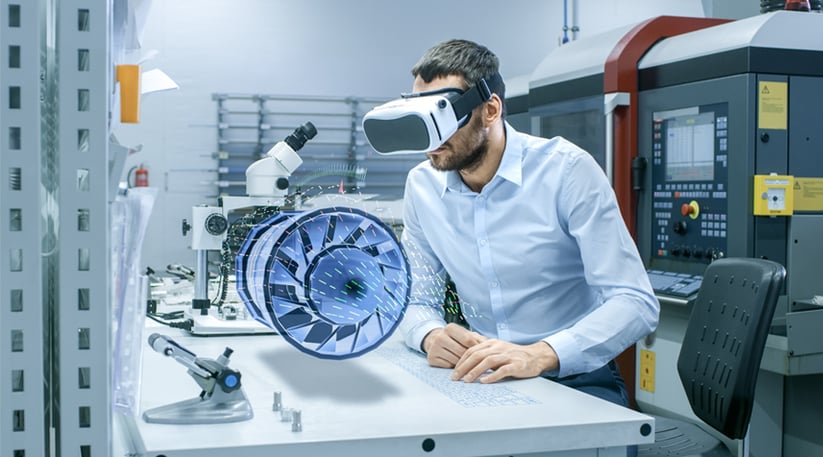AR/VR is currently creating positive disruption for a vast number of operational processes: from design and rapid prototyping to the final production and assembly.
Virtual Reality (VR) technology creates a simulated three-dimensional environment that a user can perceive as real and provides an immersive experience in the artificial environment, whereas Augmented Reality (AR) increases the user experience in the real world by layering additional digital content and information onto the physical world as if it’s in your own space. There are also emerging immersive technologies like Mixed Reality (MR) and Extended Reality (XR) which are a combination of these existing technologies.

The global virtual and augmented reality market is estimated to generate revenue of USD 22.1 billion in 2020 and is expected to reach USD 161.1 billion in 2025, witnessing a 48.8% CAGR during the forecast period. Substantial increase in use of smartphones and connected devices in various application sectors and development of the gaming industry has boosted the AR and VR market growth.
Device manufacturers like Oculus and HTC are driving the growth of the gaming market. They have hosted their own app stores with thousands of gaming and entertainment applications under various genres for different age groups.. HTC has launched VIVEPORT Infinity, the world’s first VR subscription model, a paid service to download and play the VR contents as part of the membership program. It’s a major breakthrough for the users to access 2000+ titles at an affordable cost, hence it is often portrayed as Netflix for VR by the gaming community. The Steam platform is the largest digital distribution platform in PC gaming market.
However, the VR market is extending rapidly to enterprise users.
Enterprise segment is anticipated to be one of the most lucrative segments that will showcase highest growth rate in the next five years. It is estimated that the Enterprise VR apps market will exceed US$5 billion by 2024 in the US, of which the government’s share of usage touching US$330 million by 2024.
Various enterprise sectors like education, healthcare, manufacturing, and automotives are increasingly adopting AR/VR solutions.
In the healthcare sector is one of the biggest adopters of VR solutions, next to the gaming and entertainment industries. VR offers an array of applications in areas such surgery simulation, pain management, doctors skills training, physical therapy, and phobia treatment to name a few. The major advantage of this technology is that it allows doctors to learn new skills in a safe environment, for example, by replicating common surgical procedures in the VR environment before the actual surgery.
We are in the midst of the fourth industrial revolution - Industry 4.0, a new phase in which the manufacturing industry is focusing on automation, Interconnectivity (IIoT), Machine Learning, and Artificial Intelligence to create new ways of operating. The potential for the use of VR applications in manufacturing is huge, especially in areas like product R&D, workplace design and layout, inventory management, remote maintenance and servicing of equipment, workers safety and real-time employee training and much more.
 The technology addresses some of the key challenges in manufacturing such as the need for skilled labour. The technical work force could be upskilled on the use of the latest equipment in a virtual environment, mitigating the risk of hazards and injuries. Training the engineers before deploying them in the assembly line reduces the defective rates and helps manufacturer achieve quality goals.
The technology addresses some of the key challenges in manufacturing such as the need for skilled labour. The technical work force could be upskilled on the use of the latest equipment in a virtual environment, mitigating the risk of hazards and injuries. Training the engineers before deploying them in the assembly line reduces the defective rates and helps manufacturer achieve quality goals.
This immersive technology helps right from the design phase. Automotive manufacturers leverage VR apps to build prototypes, cutting down on development time and cost.
VR could play a strong role in the new remote work paradigm. A few companies are building prototypes that facilitate remote work using Mixed Reality which is a blend of both Augmented Reality (AR) and VR.
In addition, businesses worldwide are starting to explore how VR can help create a more attractive, immersive product experience for their customers. With this exploration comes unseen challenges involving plenty of innovative development and lots of QA testing work.
VR helps improve the student learning experience. It transforms the way educational content is delivered and keeps learning session more interactive, making them acquire skills through simulations. Popular applications like Google Expeditions, Discovery VR, Boulevard Virtual field trips apps are few names worth mentioning here.
While the potential is vast for the use cases for VR, there is still scope for improving the technology itself. The next generation VR applications will have higher resolution that demands the adoption of advanced technologies like 5G that reduces the latency to provide an immersive experience to the users. The roll out of 5G network promises immense network speed, lower latency and reliability.
The industry is gearing up to provide solutions and infrastructure to leverage the efficiency of 5G technology. A Taiwanese manufacturer has developed a 5G Hub, powered by Qualcomm ® Snapdragon™ forecasting the role of 5G and Edge Computing in streaming VR content from the cloud to cable free headsets for high-end VR experience in real time. CloudXR SDK, will enable companies to offer VR/AR experiences from the cloud infrastructure or on-premise. It provides a way to stream graphics-intensive AR/VR/MR applications over a 5G network to one or more devices which runs on a moderately low-powered graphics configuration.
VR/AR is no longer a technology meant only for the gaming and entertainment industry. It has now become a viable part of any companies’ expansion plans or integrated operations. The growth in enterprise is anticipated to be exponential with the arrival of 5G networks, Cloud, Edge computing and AI.
Innominds Quality Engineering and Testing Services play a pivotal role in taking the VR game and entertainment testing experience to the next level by providing increased, active user engagement to VR gaming platform users.
Apart from working with the gaming industry, we are using our all-round solution expertise in product engineering, QA, testing, test automation, embedded and chip engineering, platform integration, security, and emerging technologies to explore better ways to empower businesses especially AR/VR/MR companies that are looking to provide a seamless immersive experience to the diversified Enterprise segments.




